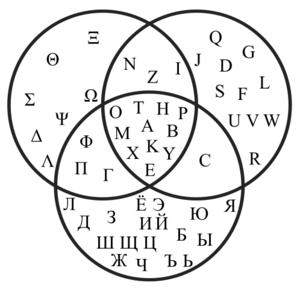Venn diagram (nonfiction): Difference between revisions
Jump to navigation
Jump to search

No edit summary |
|||
| Line 26: | Line 26: | ||
* [https://en.wikipedia.org/wiki/Venn_diagram Venn diagram] @ Wikipedia | * [https://en.wikipedia.org/wiki/Venn_diagram Venn diagram] @ Wikipedia | ||
* [http://www.readwritethink.org/files/resources/interactives/venn_diagrams/ Online Venn diagram generator] @ readwritethink.org | |||
* [http://creately.com/Draw-Venn-Diagrams-Online Online Venn diagram generator] @ creately.com/ | |||
* [http://www.bioinformatics.lu/venn.php Online Venn diagram generator] @ bioinformatics.lu | |||
* [http://www.classtools.net/education-games-php/venn_intro Online Venn diagram generator] @ classtools.net | |||
* [https://www.meta-chart.com/venn Online Venn diagram generator] @ meta-chart.com | |||
[[Category:Nonfiction (nonfiction)]] | [[Category:Nonfiction (nonfiction)]] | ||
Revision as of 15:52, 8 August 2016

Venn diagram showing which uppercase letter glyphs are shared by the Greek, Latin and Russian alphabets.
A Venn diagram (also known as a set diagram or logic diagram) is a diagram that shows all possible logical relations between a finite collection of different sets.
Venn diagrams are a special case of Euler diagrams, which do not necessarily show all relations.
Venn diagrams were conceived around 1880 by John Venn.
They are used to teach elementary set theory, as well as illustrate simple set relationships in probability, logic, statistics, linguistics and computer science.
In the News
John Venn gathers his thoughts, groups them into logical categories.
Fiction cross-reference
Nonfiction cross-reference
External links:
- Venn diagram @ Wikipedia
- Online Venn diagram generator @ readwritethink.org
- Online Venn diagram generator @ creately.com/
- Online Venn diagram generator @ bioinformatics.lu
- Online Venn diagram generator @ classtools.net
- Online Venn diagram generator @ meta-chart.com
